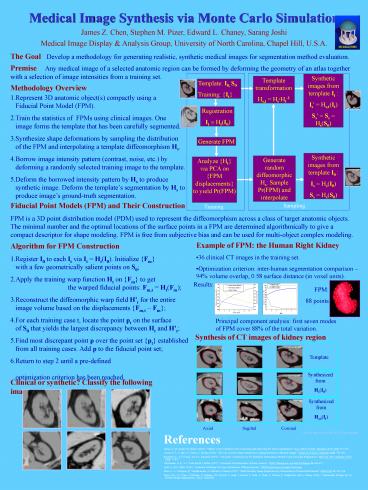Medical Image Synthesis via Monte Carlo Simulation - PowerPoint PPT Presentation
Title:
Medical Image Synthesis via Monte Carlo Simulation
Description:
... used to represent the diffeomorphism across a class of target anatomic objects. ... Register I0 to each It via It = Ht(I0) ... – PowerPoint PPT presentation
Number of Views:29
Avg rating:3.0/5.0
Title: Medical Image Synthesis via Monte Carlo Simulation
1
Medical Image Synthesis via Monte Carlo
Simulation James Z. Chen, Stephen M. Pizer,
Edward L. Chaney, Sarang Joshi Medical Image
Display Analysis Group, University of North
Carolina, Chapel Hill, U.S.A.
The Goal Develop a methodology for generating
realistic, synthetic medical images for
segmentation method evaluation.
Premise Any medical image of a selected
anatomic region can be formed by deforming the
geometry of an atlas together with a selection of
image intensities from a training set.
Synthetic images from template It Is'
Hs,t(It) Ss' Ss Hs(S0)
Template transformation Hs,t HsHt-1
Template I0, S0 Training It
Methodology Overview
- Represent 3D anatomic object(s) compactly using a
Fiducial Point Model (FPM). - Train the statistics of FPMs using clinical
images. One image forms the template that has
been carefully segmented. - Synthesize shape deformations by sampling the
distribution of the FPM and interpolating a
template diffeomorphism Hs. - Borrow image intensity pattern (contrast, noise,
etc.) by deforming a randomly selected training
image to the template. - Deform the borrowed intensity pattern by Hs to
produce synthetic image. Deform the templates
segmentation by Hs to produce images
ground-truth segmentation.
Registration It ? Ht(I0)
Generate FPM
Synthetic images from template I0 Is
Hs(I0) Ss Hs(S0)
Generate random diffeomorphic Hs Sample Pr(FPM)
and interpolate
Analyze Ht via PCA on FPM displacements to
yield Pr(FPM)
Fiducial Point Models (FPM) and Their
Construction FPM is a 3D point distribution model
(PDM) used to represent the diffeomorphism across
a class of target anatomic objects. The minimal
number and the optimal locations of the surface
points in a FPM are determined algorithmically to
give a compact descriptor for shape modeling.
FPM is free from subjective bias and can be used
for multi-object complex modeling.
Sampling
Training
- Example of FPM the Human Right Kidney
- 36 clinical CT images in the training set.
- Optimization criterion inter-human segmentation
comparison 94 volume overlap, 0.58 surface
distance (in voxel units).
- Algorithm for FPM Construction
- Register I0 to each It via It Ht(I0).
Initialize Fm with a few
geometrically salient points on S0 - Apply the training warp function Ht on Fm to
get the warped fiducial points Fm,t
Ht(Fm) - Reconstruct the diffeomorphic warp field H't for
the entire image volume based on the
displacements Fm,t Fm - For each training case t, locate the point pt on
the surface of S0 that yields the largest
discrepancy between Ht and H't - Find most discrepant point p over the point set
pt established from all training cases. Add p
to the fiducial point set - Return to step 2 until a pre-defined
optimization criterion has been reached.
Results
FPM 88 points
Principal component analysis first seven modes
of FPM cover 88 of the total variation.
Synthesis of CT images of kidney region
Clinical or synthetic? Classify the following
images.
A
B
C
Axial
Sagittal Coronal
Key for quiz in lower left B,C,D,E are synthetic.
References Gerig, G., M. Jomier, M. Chakos
(2001). Valmet A new validation tool for
assessing and improving 3D object segmentation.
Proc. MICCAI 2001, Springer LNCS 2208
516-523. Cootes, T. F., A. Hill, C.J. Taylor, J.
Haslam (1994). The Use of Active Shape Models
for Locating Structures in Medical Images. Image
and Vision Computing 12(6) 355-366. Rueckert,
D., A.F. Frangi, and J.A. Schnabel (2001).
Automatic Construction of 3D Statistical
Deformation Models Using Non-rigid Registration.
MICCAI 2001, Springer LNCS 2208
77-84. Christensen, G. E., S.C. Joshi and M.I.
Miller (1997). Volumetric Transformation of
Brain Anatomy. IEEE Transactions on Medical
Imaging 16 864-877. Joshi, S., M.I. Miller
(2000). Landmark Matching Via Large Deformation
Diffeomorphisms. IEEETransactions on Image
Processing. Maes, F., A. Collignon, D.
Vandermeulen, G. Marchal, P. Suetens (1997).
Multi-Modality Image Registration by
Maximization of Mutual Information. IEEE-TMI 16
187-198. Pizer, S.M., J.Z. Chen, T. Fletcher, Y.
Fridman, D.S. Fritsch, G. Gash, J. Glotzer, S.
Joshi, A. Thall, G. Tracton, P. Yushkevich, and
E. Chaney (2001). Deformable M-Reps for 3D
Medical Image Segmentation. IJCV, submitted.
F
E
D































